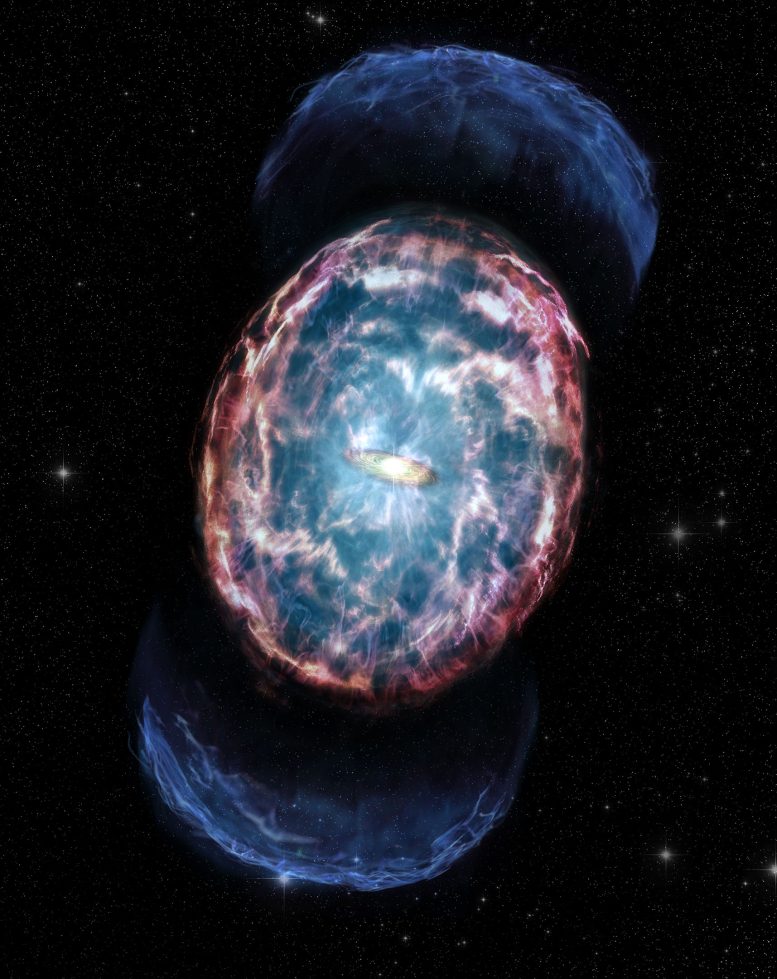
La interpretación del artista ilustra las consecuencias de una «kilonova», un poderoso evento que ocurre cuando dos estrellas de neutrones se fusionan. Crédito: Rayos X: NASA/CXC/Northwestern Univ./A. Hajela et al.; Ilustración: NASA/CXC/M. Weiss
Una extraña «explosión de sonido» estuvo acompañada de un evento sin precedentes.
- Misteriosos rayos X vistos 3,5 años después de la fusión de dos estrellas de neutrones
- Los astrofísicos creen que las kilonovas auroras o materiales caen en una[{» attribute=»»>black hole might have caused the X-ray emission
- Either scenario would be the first for the field
- The kilonova afterglow was likely produced by a shock similar to a sonic boom, generated by expanding debris from the merger
For the first time, Northwestern University-led astronomers may have detected an afterglow from a kilonova.
A kilonova occurs when two neutron stars — some of the densest objects in the universe — merge to create a blast 1,000 times brighter than a classical nova. In this case, a narrow, off-axis jet of high-energy particles accompanied the merger event, dubbed GW170817. Three-and-a-half years after the merger, the jet faded away, revealing a new source of mysterious X-rays.
As the leading explanation for the new X-ray source, astrophysicists believe expanding debris from the merger generated a shock — similar to the sonic boom from a supersonic plane. This shock then heated surrounding materials, which generated X-ray emissions, known as a kilonova afterglow. An alternative explanation is materials falling toward a black hole — formed as a result of the neutron star merger — caused the X-rays.
Cualquier escenario sería el primero de su tipo en el campo. El estudio fue publicado el 28 de febrero de 2022 en Cartas de revistas astrofísicas.
«Hemos entrado en un territorio desconocido aquí para estudiar los efectos de una fusión de estrellas de neutrones», dijo Abrajita Hajela de Northwestern, quien dirigió el nuevo estudio. «Estamos buscando algo nuevo e inusual por primera vez. Esto nos brinda la oportunidad de estudiar y comprender nuevos procesos físicos, que no se habían observado antes».
Hajela es estudiante de posgrado en el Centro Noroeste para la Exploración e Investigación Interdisciplinaria en Astrofísica (CIERA) y en el Departamento de Física y Astronomía de la Facultad de Artes y Ciencias de Weinberg.
El 17 de agosto de 2017, GW170817 pasó a la historia como la primera fusión de estrellas de neutrones detectada por ambos[{» attribute=»»>gravitational waves and electromagnetic radiation (or light). Since then, astronomers have been using telescopes around the world and in space to study the event across the electromagnetic spectrum.
We are looking at something new and extraordinary for the very first time.”
— Aprajita Hajela, astrophysicist
Using NASA’s Chandra X-ray Observatory, astronomers observed X-ray emissions from a jet moving very close to the speed of light produced by the neutron star merger. Starting in early 2018, the jet’s X-ray emission steadily faded as the jet continued to slow and expand. Hajela and her team then noticed from March 2020 until the end of 2020, the decline in brightness stopped, and the X-ray emission was approximately constant in brightness.
This was a significant clue.
“The fact that the X-rays stopped fading quickly was our best evidence yet that something in addition to a jet is being detected in X-rays in this source,” said Raffaella Margutti, astrophysicist at the University of California at Berkeley and a senior author of the study. “A completely different source of X-rays appears to be needed to explain what we’re seeing.”
The researchers believe a kilonova afterglow or black hole are likely behind the X-rays. Neither scenario has ever before been observed.
“This would either be the first time we’ve seen a kilonova afterglow or the first time we’ve seen material falling onto a black hole after a neutron star merger,” said study co-author Joe Bright, also from the University of California at Berkeley. “Either outcome would be extremely exciting.”
To distinguish between the two explanations, astronomers will keep monitoring GW170817 in X-rays and radio waves. If it is a kilonova afterglow, the X-ray and radio emissions are expected to get brighter over the next few months or years. If the explanation involves matter falling onto a newly formed black hole, then the X-ray output should stay steady or decline rapidly, and no radio emission will be detected over time.
“Further study of GW170817 could have far-reaching implications,” said study co-author Kate Alexander, a CIERA postdoctoral fellow at Northwestern. “The detection of a kilonova afterglow would imply that the merger did not immediately produce a black hole. Alternatively, this object may offer astronomers a chance to study how matter falls onto a black hole a few years after its birth.”
The study, “Evidence for X-ray emission in excess to the jet afterglow decay 3.5 years after the binary neutron star merger GW170817: A new emission component,” was supported by NASA, the National Science Foundation, the U.S. Department of Energy and the Royal Astronomical Society.






More Stories
Los legionarios realizan dos cruceros separados vinculados a esta característica especial de lujo: informe
La supernova vista por primera vez en 1181 libera filamentos brillantes
SpaceX lanza 20 satélites de Internet Starlink desde California el 30 de octubre